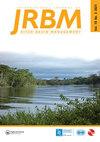从印度季风季节的TIGGE集合中选择更长的定量降水预报数据集
IF 1.9
Q3 WATER RESOURCES
International Journal of River Basin Management
Pub Date : 2023-10-20
DOI:10.1080/15715124.2023.2270971
引用次数: 0
摘要
降水模式的变化和极端事件的增加使得对印度夏季风降水的可靠预报至关重要。我们需要更长的预报数据记录来开发一个流量预报系统。为了从THORPEX交互式大全球集合(TIGGE)档案中选择合适的数据集,我们应用了两个标准:(i)数据集的长度应该至少有10年的连续记录,(ii)预测产品应该至少有20个集合成员,提前期至少为5天。本文对2011 - 2020年整个季风季节(6 - 9月)印度地区四个国际机构的集合定量降水预报(QPFs)进行了评价。我们特别研究了22个流域的QPFs在预测正常和极端降水事件方面的准确性。使用全球降水综合多卫星检索(IMERG)数据作为同期观测资料。我们的目标是在每个流域分配最佳QPF。qpf的熟练程度是用确定性、二分类和概率误差统计的六个标准来评估的。误差值分为低、中、高三类。使用给定的四个QPF,以及六个误差统计中的每一个的三个类别来制定预测可靠性指数,以回答(A)哪个QPF在哪个流域表现更好,以及(b)是否可以对印度所有流域的QPF的整体表现做出任何结论。关键词:定量降水预报,档案,预报可靠性指数,极端降水,河流流域免责声明作为对作者和研究人员的服务,我们提供此版本的接受稿件(AM)。在最终出版版本记录(VoR)之前,将对该手稿进行编辑、排版和审查。在制作和印前,可能会发现可能影响内容的错误,所有适用于期刊的法律免责声明也与这些版本有关。我们感谢编辑、副编辑和两位匿名审稿人对本文的评论和建议。由于科学和工程研究委员会(塞尔维亚)的支持,这项研究得以完成。印度政府科技部(项目编号CRG/2022/004006)授予Sanjeev Kumar Jha。本文章由计算机程序翻译,如有差异,请以英文原文为准。
Towards the selection of a longer record of quantitative precipitation forecast dataset from TIGGE ensembles for India during the monsoon season
AbstractChanging precipitation patterns and increased extreme events make a reliable forecast of summer monsoon precipitation crucial in India. We need a longer record of forecast data to develop a streamflow forecasting system. To select a suitable dataset from the THORPEX Interactive Grand Global Ensemble (TIGGE) archives, we applied two criteria: (i) the length of the dataset should be at least 10 years of continuous record, and (ii) the forecast product should have at least 20 ensemble members for a lead time of minimum 5 days. We evaluate the ensemble quantitative precipitation forecasts (QPFs) obtained from the four selected international agencies over the Indian region throughout the monsoon season (June to September) from 2011 to 2020. We specifically looked at the accuracy of QPFs in 22 river basins in forecasting normal and extreme precipitation events. Data from the Integrated Multi-satellite Retrievals for Global Precipitation Measurement (IMERG) is used as observation data for the same period. We aim to assign the best QPF in each river basin. The proficiency of QPFs is evaluated using six criteria from deterministic, dichotomous, and probabilistic error statistics. The error values are classified into three categories – low, moderate, and high. A Forecast Reliability Index is formulated using the given four QPFs, and three categories for each of the six error statistics to answer (a) which QPF shows better performance in which river basin and (b) whether any conclusion can be made on the overall performance of a QPF for all the River Basins of India.Keywords: Quantitative Precipitation ForecastsTIGGE archiveForecast Reliability IndexExtreme precipitationRiver basinsDisclaimerAs a service to authors and researchers we are providing this version of an accepted manuscript (AM). Copyediting, typesetting, and review of the resulting proofs will be undertaken on this manuscript before final publication of the Version of Record (VoR). During production and pre-press, errors may be discovered which could affect the content, and all legal disclaimers that apply to the journal relate to these versions also. AcknowledgementsWe thank to the Editor, Associate Editor, and two anonymous Reviewers for their comments and suggestions on this manuscript. This research was completed thanks to the support of the Science and Engineering Research Board (SERB). Department of Science and Technology, Government of India (project number CRG/2022/004006) awarded to Sanjeev Kumar Jha.
求助全文
通过发布文献求助,成功后即可免费获取论文全文。
去求助
来源期刊

International Journal of River Basin Management
WATER RESOURCES-
CiteScore
6.00
自引率
4.00%
发文量
48
期刊介绍:
include, but are not limited to new developments or applications in the following areas: AREAS OF INTEREST - integrated water resources management - watershed land use planning and management - spatial planning and management of floodplains - flood forecasting and flood risk management - drought forecasting and drought management - floodplain, river and estuarine restoration - climate change impact prediction and planning of remedial measures - management of mountain rivers - water quality management including non point source pollution - operation strategies for engineered river systems - maintenance strategies for river systems and for structures - project-affected-people and stakeholder participation - conservation of natural and cultural heritage
 求助内容:
求助内容: 应助结果提醒方式:
应助结果提醒方式:


